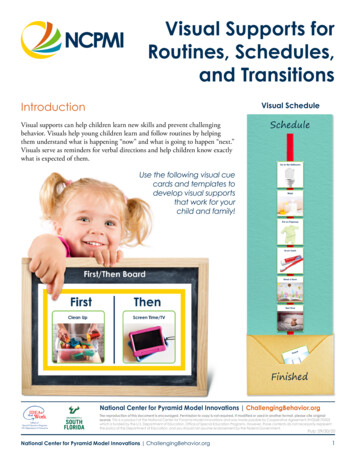
Transcription
PART II: Practice Routines forThe Improvement KataDeliberate practice of the Improvement Kata patternhas the ability to change how we think about and dealwith challenges and uncertainty. This section of theHandbook walks you step-by-step through the practiceroutines for each step of the Improvement Kata.Each Chapter in this section has two parts: a ʻConceptOverviewʼ and ʻPractice Routines,ʼ indicated by theseicons: Mike Rother / Improvement Kata HandbookDirection1
WHAT PART II IS ABOUTThe practice routines in this part of the Handbook are usedto learn the scientific thinking pattern of the ImprovementKata. The practice routines in Part III are used to learn howto teach the Improvement Kata pattern.The IMPROVEMENT KATA PATTERN(the scientific approach)These are specific PRACTICEROUTINES to acquire / developthe scientific pattern ofthinking and actingThe COACHING KATA is apractice routine for learninghow to teach theImprovement Kata pattern(HANDBOOK PART II)(HANDBOOK PART III) Mike Rother / Improvement Kata HandbookDirection2
THE STEPS OF THE IMPROVEMENT KATABUILD ON ONE ANOTHER4What you do in one stepframes the next step3The more precisely you define the Target Condition,the better and more quickly you can recognize obstaclesand Iterate toward it with rapid experiments .2The better your analysis of the Current Condition,the more precise your definition of the TargetCondition can be.1The clearer the definition of the Challenge,the more appropriate will be your analysisof the Current Condition. Mike Rother / Improvement Kata HandbookDirection3
THE STEPS OF THE IMPROVEMENT KATAARE ALSO RECURSIVEWhat you encounter in one stepmay adjust what you learned in earlier steps12 Mike Rother / Improvement Kata Handbook34Direction4
PLANNING PHASEWhere Do We Want to Go?Chapter 4. Step 1: Understand the Direction / ChallengeChapter 5. Step 2: Grasp the Current ConditionChapter 6. Step 3: Establish the Next Target ConditionImprovementKataCoachingKata Mike Rother / Improvement Kata HandbookDirection5
Chapter 4The Improvement Kata - Planning PhasePracticethisRoutineStep 1: UNDERSTAND THEDIRECTION / CHALLENGEFor referencesee:Chapter3 Mike Rother / Improvement Kata HandbookDirection6
ORIENTATIONUnderstandtheDirectionGrasp theCurrentConditionEstablish theNext TargetConditionIterate Towardthe TargetConditionTCTargetConditionLEARNERCCWhat 1-3 yearChallenge are westriving to meet?ʻPlanningʼ Coaching CyclesCOACH Mike Rother / Improvement Kata ection7
LEARNERʼS STORYBOARDLearner and Coach are now concentrating on this fieldFocus Process:TargetConditionAchieve by:Challenge:CurrentConditionPDCA CyclesRecordObstaclesParking Lot Mike Rother / Improvement Kata HandbookDirection8
ConceptOverview Mike Rother / Improvement Kata HandbookDirection9
STRATEGY BEFORE GOALSThe Improvement Kata pattern beginswith a sense of strategic directionBased on a graphic by Bill Costantino Mike Rother / Improvement Kata HandbookDirection10
SPECIFICALLY, THE FIRST STEP OF THE IK PATTERNIS TO HAVE AN OVERARCHING CHALLENGEThis is the context within which the rest of the Improvement Kata is appliedHaving an overarching challenge isimportant, so that individual targetconditions are seen as meaningful.Itʼs difficult for us to stay engagedwith something that doesnʼt have apurpose.NextCurrentTargetCondition Obstacles ConditionChallengeLongTermVision“When people see themselves as components in a system[and] work in cooperation to achieve a shared aim, theyfeel that their efforts hold meaning. They experienceinterest and challenge and joy in the work.” W. Edwards Deming, The New Economics, page 128 Mike Rother / Improvement Kata HandbookDirection11
LETʼS LOOK AT EACH OF THESE ELEMENTSNextCurrentTargetCondition Obstacles Condition Mike Rother / Improvement Kata HandbookChallengeLongTermVisionDirection12
LONG-TERM VISION: THE BIG IDEANextCurrentTargetCondition Obstacles ConditionChallengeLongTermVisionFarA vision is the loftiest goal for your organization.AwayItʼs a long-range ideal about value you want your organizationto provide for customers, in a broad sense. Itʼs your dream.For example, a long-term vision for an automobile company might be,“Better transportation for more people.” A vision for a maker of drillscould be, “Holes where you want them when you want them.”A vision is a puzzle from the perspective of current competencies.Itʼs far away, difficult to imagine and the path to it is not foreseeable.Vision?But a vision is not agood guide for dailyimprovement efforts.Itʼs too vague andtoo far away.CurrentCondition Mike Rother / Improvement Kata HandbookDirection13
THE MOST IMPORTANT DIRECTION GIVER IN ANORGANIZATION IS A CLOSER, MORE SPECIFIC,WELL-STATED STRATEGIC CHALLENGENextCurrentTargetCondition Obstacles ConditionChallengeLongTermVision6 Months to3 Years outThe Challenge is thecontext, or “frame,”for the three stepsof the ImprovementKata that follow Mike Rother / Improvement Kata HandbookDirection14
WHAT IS AN OVERALL CHALLENGE?A challenge is a description of success1-3 years in the future A challenge is a new condition that you envision, which willcause you to stretch and grow. As you try to describe yourchallenge, think of the words: “Wouldnʼt it be great if we could.” In business organizations itʼs a description of a new level orpattern of performance related to better serving the customer,which will differentiate your offering from other offerings. Itʼs something you canʼt achieve using the current system orprocess. A challenge is typically 6 months to 3 years in the future.It cannot be reached quickly in a few steps. Not easy, but not impossible. Achievable, but we donʼt knowin advance how weʼll achieve it. Takes a series of targetconditions to achieve. Does not state how to get there or present a value judgement. Mike Rother / Improvement Kata HandbookDirection15
THE ROLE OF CHALLENGE IN AN ORGANIZATIONAn overall Challenge is a theme that helpsconnect strategy with executionManagers develop people bycoaching application practiceof the Improvement Kata inthe direction of the challengeNextCurrentTargetCondition Obstacles ConditionExecution Mike Rother / Improvement Kata HandbookLeaders establish theorganizationʼs strategicconcept (the “rallyingpoint” or overall 6
WHY AN OVERARCHING CHALLENGEIS SO IMPORTANTThe overall challenge guides every dayʼs work.Without it: An organization is unaligned. Improvement efforts andproposals get ROI-evaluated independently, instead ofas part of reaching for something. We tend to useshort-term cost/benefit analysis to choose what stepsto take, which dangerously keeps us inside our currentknowledge threshold. We tend to jump from one direction to another in tryingavoid obstacles, rather than struggling through theobstacles to achieve the innovations and importantcompetencies of tomorrow. Improvement becomes reacting to problems(“troubleshooting” to maintain the status quo) ratherthan reaching for a new level of performance and thefuture of our choosing.Without an overarching challenge teams can get dragged down byproblems. With a challenge we can develop a higher energy level. Mike Rother / Improvement Kata HandbookDirection17
AN OVERALL CHALLENGE HELPS TO ALIGN ANDCONNECT INDIVIDUAL IMPROVEMENT EFFORTSThe overall challenge is used to help ensure that process-levelimprovement efforts have a focus and fit togetherTargetProcess Team A ConditionNextTargetConditionTargetProcess Team B ConditionNextTargetConditionTargetProcess Team C ConditionNextTargetCondition Mike Rother / Improvement Kata HandbookWhatʼs the direction in whichprocesses should be improved?What is the overarchingbreakthrough challenge that eachprocess should help achieve?ChallengeLongTermVisionA challenge typicallypertains to morethan one process inthe organization orvalue stream.Direction18
Practice Routines Mike Rother / Improvement Kata HandbookDirection19
CHALLENGE-DEVELOPMENT QUESTIONSA basic question to ask yourself is:“Wouldnʼt it be great if we could !”1. What is the distant, very long-term vision for ourorganization? What challenge will now help us movein that direction?2. What do our customers value that they are notcurrently getting from us?3. What special product or service capability do wewant to develop?4. What changes are happening in our environmentthat could make our current capabilities less special?5. What does success three years from now look like? Mike Rother / Improvement Kata HandbookDirection20
Note:EFFICIENCY AND COST CUTTINGALONE ARE NOT A DIRECTIONJust pursuing low cost is unlikely to be a source of sustainedcompetitive advantage. This can lead you into a commodity trap,where in order to compete you end up pursuing ever-lower-costinputs and endanger quality. It can easily lead to a static andvulnerable organization.Rather than managing the operational side of the business simplyto be efficient, with the Improvement Kata approach managersguide activities that support a strategic purpose that grows anddifferentiates the business (which can include efficiency, ofcourse). Strive to better serve customers and distinguish yourorganization from competitors. Cutting cost and improvingefficiency can be done as necessary to achieve this.Defining a vision or strategic purpose is about building uniquevalue; i.e., distinctive differences that are valuable to customers.This provides qualitative directional guidance for the organization. Mike Rother / Improvement Kata HandbookDirection21
ValueStreamMappingYOU CAN ESTABLISHOVERALL CHALLENGE THROUGHA FUTURE-STATE VS MAPFuture-State Mapping at theproduct-family level can provide thenecessary sense of direction andchallenge for the IK pattern.A future-state Value Stream map issometimes even called a Challenge Map.UnderstandtheDirectionGrasp theCurrentConditionEstablish theNext TargetConditionIterate Toward theTarget ConditionTCTargetConditionCC Mike Rother / Improvement Kata HandbookDirection22
WHERE VALUE STREAM MAPPING FITS INThe 4 Steps of the Improvement KataOrganizationLevel(1)(2)(3)Understandthe Directionor ChallengeGrasp theCurrentConditionEstablish theNext TargetCondition(4)IterateToward theTarget ConditionOrganizationʼs vision and strategic objectivesCurrent-State Future-StateValue Stream Value StreamMappingMappingValue StreamLevelProcessLevelPLANNING PHASEEXECUTINGDiagram by Emiel Van Est Mike Rother / Improvement Kata HandbookDirection23
HOW IT WORKSThe diagram on the previous page & below depicts how the four stepsof the Improvement Kata pattern are utilized at each level of anorganization. The diagonal arrows show how the Target Condition atone level becomes the Direction or Challenge for the next level down.At the value-stream level, current-state value stream mapping is usedfor the Kata step of grasping the current condition, and future-statemapping is used for the Kata step of establishing the Target Condition.VSM is then often also used to assess and design value stream loops.Future-state value streammaps define the direction orchallenge for improvementat the work processesinside that value stream Mike Rother / Improvement Kata HandbookDirection24
A FUTURE-STATE VALUE STREAM MAPCOORDINATES IMPROVEMENT EFFORTSA future-state map describes in a graphic format howyou want a value stream to be functioning in 1-3 years.The future-state value stream map provides anoverarching challenge & coordination for establishingtarget conditions at the individual loops and processesinside a value stream.What do the processes inside this VSloop need to work on, to help achievethe future-state value stream design? Mike Rother / Improvement Kata HandbookSee p.86 inLearning to SeeDirection25
ONCE YOUR FUTURE-STATE MAP IS DRAWN,WRITE THE OVERALL CHALLENGE AS A STATEMENTThe overall challenge should describe a desired state that people can relateto and rally around, that is measureable in some aspect. But the challengeis not just a number. It should be personally relevant to the members ofthe organization. A good challenge focuses a teamʼs attention and effortand is often published as a compact, inspiring challenge statement.Example ChallengesWouldnʼt it be great if we could. .machine parts 1x1 directly inthe assembly process. .paint parts 1x1 directly inthe assembly process. .build one customer kitchen at atime and put it right on the truck. .have lab-test results done in45 minutes, with no errors. .take 7 days from new patientreferral to evaluation. .assemble the day ordered, andship the next day. Mike Rother / Improvement Kata HandbookExampleChallenge Statement“Machine to assemble”“Paint to assemble”“Build to truck, kitchen at a time”“Know in 45”“Just a week”“Same day, next day”Direction26
IS THERE A COMMON, UNIVERSAL CHALLENGEFOR BUSINESS ORGANIZATIONS?Much of human endeavor involves striving toward what onemight call, “1x1 flow at lowest energy” - or - “the customergetting the value that is wanted or needed, when and whereit is wanted or needed.”This can be seen as a general challenge around:1) Produce to each customerʼs order2) With a short lead timeOf course, each organization would state this challengemore specifically and in a way that fits to itʼs customers,products and situation. Notice also that a wide range ofimprovement activity involving everyone in an organizationwill ultimately be necessary in striving to get ever closer tothis goal.CurrentCondition Mike Rother / Improvement Kata Handbook1x1 flowat lowestenergyDirection27
THERE IS A VALUE STREAM CHALLENGEPLUS A SUBSET SPECIFIC TO YOUR PROCESSThe specific Challenge at your process will come from the TargetCondition one level above you. Challenges and Target Conditionsshould be mathematically linked up-and-down the organization.Ask: “How does the Challenge for our process relate mathematicallyto the larger (value stream) challenge?” Write your Challenge onyour storyboard.UnderstandtheDirection(from level ablishthe NextTargetConditionIterate TowardtheTarget ConditionOrganizationʼs vision and strategic objectivesValue StreamLevelChallengeProcessLevelChallengePLANNING Mike Rother / Improvement Kata HandbookEXECUTINGDirection28
DIFFERENT LEVELS OF CHALLENGEWhat coaching to a Challenge looks likeCoaches Value StreamsCoaches VS LoopsCoaches ProcessesOrganizationʼsStrategicGoalValue StreamGoalValue StreamLoop GoalProcessGoalLeadership coaches the next level down in defining an overall Challengein the direction of the vision. Below that, the Target Condition from thelevel above becomes the Direction or Challenge for the level below. Mike Rother / Improvement Kata HandbookDirection29
LETʼS LOOK AHEADTO THE REST OF THEIMPROVEMENT KATA PATTERN Mike Rother / Improvement Kata HandbookDirection30
HAVING A CHALLENGE IS NOT ENOUGHHaving a challenge without the ability to execute is ineffectiveJust issuing challenges is not sufficient for achieving improvement,adaptiveness and innovation. People in the organization also need tomaster a systematic, scientific way of working toward a challenge.Looking ahead to the rest of the Improvement Kata (where executiontakes place) itʼs a series of Target Conditions that day-to-dayimprovement efforts at each level will actually be aiming for.NextSuccessiveCurrentTargetChallengeCondition Obstacles ConditionTarget(date)Conditions1 Week to3 Months outLongTermVisionLearnerʼsStoryboardDescribes the nextdesired condition,to be reached by aspecified achieveby date.Learner Mike Rother / Improvement Kata HandbookCoachDirection31
SOME DIFFERENCES BETWEENA TARGET CONDITION AND A CHALLENGETARGET CONDITION Is developed in your areaDeveloped by the Learner,guided by the Coach(manager) Achieve-by date is 1 weekto 3 months outCHALLENGE Comes from the levelabove you 6 months - 3 years outA series of successivetarget conditions isnecessary to meet achallenge. When youachieve one targetcondition you set thenext target condition. Mike Rother / Improvement Kata HandbookDirection32
Finally. Obstacles to each Target Conditionare where rapid experimentation takes placeThis iterating (experimenting) toward the Target ConditionNextCurrentTargetCondition Obstacles ConditionChallengeLongTermVisionHere weʼve reached the level wherethe action of improvement, adaptation,evolution and innovation takes place.You work on only those obstaclesthat you successivly find arepreventing you from achieving thespecified Target Condition.Through that Target Condition (thestrive vector) the experimentsare linked to achieving the challenge. Mike Rother / Improvement Kata HandbookDirection33
A MANUFACTURING EXAMPLEThis teamʼs Target Condition is in-line paint-drying ovenwith certain attributesVISIONDrying Oven(being developed)ChainConveyor Mike Rother / Improvement Kata HandbookCHALLENGEOR THEMENEXT TARGETCONDITIONCURRENTOBSTACLEMoreGeneral1x1 FlowPaint in LineIn-Line Oven(attributes defined)Chain conveyor Moreis derailingSpecificCurrent Obstacle:DetailedThe chain conveyor derailsExperiments when parts are hung on it.are hereThe team is nowexperimenting here.Direction34
HOW THE IMPROVEMENT KATA PATTERN ALIGNSWITH THE STEPS OF TRADITIONAL SCIENCEThis Handbook seeks to teach Scientific Thinking in a way thatrelates to everyday life in business, education, politics and athome. Although the emphasis here is more on ʻstrivingʼ ratherthan just scientific ʻunderstanding,ʼ the Improvement Katapattern is well aligned with how scientists traditionally work.Improvement KataTraditional SciencePatternExample“Research Topic”ChallengePaint in Line“Research Problem”Target ConditionIn-Line Oven“Research n conveyoris derailingTest a differentchainq q q Mike Rother / Improvement Kata Handbookq q q Direction35
SUMMARYThis trajectory goes frommore specific & measurableon the lower left, to lessspecific & measureableon the upper right.FarAway6 Months to3 Years outThisChapter1 Week to3 Months outNext 3Chapters Mike Rother / Improvement Kata HandbookDirection36
At the value-stream level, current-state value stream mapping is used for the Kata step of grasping the current condition, and future-state mapping is used for the Kata step of establishing the Target Condition. VSM is then often also used to assess and design value stream loops. Future-state











